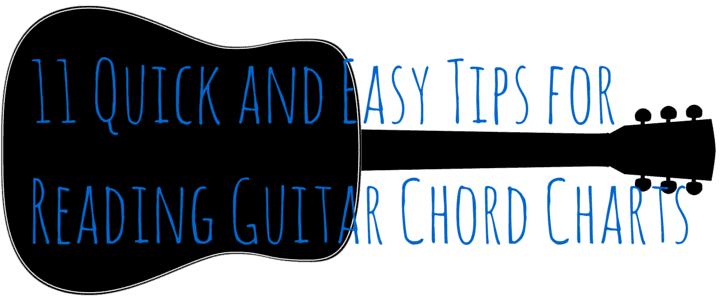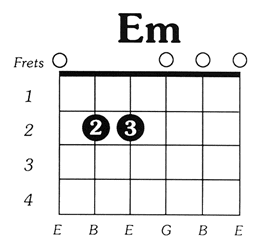While it’s true that you don’t need to read music to play the guitar, you should learn how to read guitar chord charts. A guitar key chart is a visual representation of a chord.
This helpful visual is a little like music-by-numbers; it tells you which finger goes where and on what string, so in case you come across a chord you don’t know, you’ll be able to play it. Here’s an example of a guitar chord chart, also known as a guitar chord diagram:
Guitar chord charts are a cinch to read once you learn what all the lines, numbers, and circles mean. Are you ready to start learning how to play songs on the guitar? Here are 11 things you need to read guitar fingering charts.
11 Tips for How to Read Chord Charts
Here are our 11 tips for reading guitar chord charts.
Visualization
The grid of six vertical and five horizontal lines represents the guitar fretboard. If you’re having trouble understanding the basic layout of the image above, hold your guitar in front of you so that the strings are facing you and the headstock is pointing up.
The image of the guitar chord chart represents this same view of your guitar, with strings running vertically and frets horizontally.
Which End Is Up?
Guitar chord charts are more commonly situated vertically (like above) rather than horizontally, especially in songbooks. It’s good to learn to interpret both vertical and horizontal grids though.
Righty or Lefty?
Since guitar chord charts are typically written for right-handed guitarists, they provide a challenge to left-handed players, who have to do a bit of re-visualization by flipping the chart around. If a given source doesn’t provide a left-handed version, you can download left-handed guitar chord charts online.
Chord Name
The letter at the top of the chart is the name of the chord in the guitar chord diagram.
RELATED: 20 Easy Songs with Basic Guitar Chords
Vertical Lines
The vertical lines on a guitar fingering chart represent the six strings of the guitar. The low E string (the thickest one) is on the left of the diagram, followed by the A, D, G, B and high E string, which is on the right of the diagram.
The string names are sometimes noted at the bottom of the guitar note chart.
Horizontal Lines
The horizontal lines on the chart represent the metal frets on the neck of the guitar. The top line will generally be bolded or marked by a double line, which indicates the guitar’s nut. Fret numbers are sometimes noted to the left of the sixth string.
Chords Beyond the 4th Fret
If the guitar fingering chart is depicting frets higher than the fourth fret, the top line on the chart will not be bolded (or doubled) and fret numbers will be shown, either to the left of the sixth string or to the right of the first string, to help orient you on the fretboard.
SEE ALSO: How to Read Guitar Tabs
Black Dots
The black (or red) dots on the diagram tell you which frets and strings to place your fingers on. The numbers inside the dots indicate which fingers to use on each of the frets. They correspond to the four fingers of the fretting hand.
Number 1 is the index finger, 2 is the middle finger, 3 is the ring finger, and 4 is your pinky. You don’t use the thumb to fret, except in certain unusual circumstances. In those cases there would be a “T” inside the black dot.
Fingerings can also sometimes be found written along the bottom of the strings of a chord chart, or between the nut mark and the chord name instead of inside the dots.
X’s and O’s
An “X” above the bolded nut mark indicates a string you don’t pick or strum. An “O” in the same location means to play the string open.
Alternate Fingerings
You may come across a suggested chord fingering that you simply cannot contort your fingers to play. In this case try experimenting with alternate fingerings. The most commonly used chord fingerings, however, will work for most guitarists.
How a Barre Chord Is Charted
As you probably already know, barre chords are chords that involve using one finger, usually your index finger, to hold down multiple strings in a single fret simultaneously.
A barre is noted on a guitar chord diagram by a curved or solid line running through a fret from the first note to the last note of the chord, or by a series of dots in the same fret that all bear the same number.
Ready to give it a shot? Check out this infographic from Guitar Domination to learn 32 essential guitar chord diagrams. [Preview below]

Guitartricks.com is an online subscription service that has provided video guitar lessons for beginners and advanced players since 1998. The site has more than 11,000 video lessons and 600+ song tutorials. Learn more about the site with this Guitar Tricks Review.
Suzy S.


